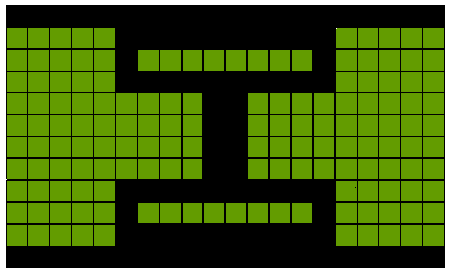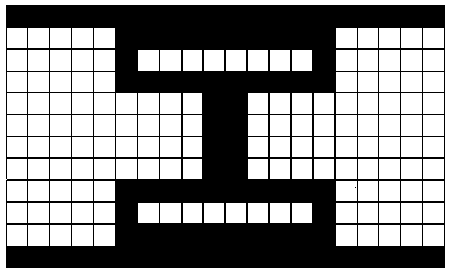The Ball Game

Science in Ancient Artwork |

Dedicated to Dylin
Table of ContentsIntroduction |
In this essay, the author explores the possible relationships between the maya companion numbers (1366560; 1385540) and
the numbers of the ancient Egyptian Sothic cycle (533265; 1066530). These historically significant numbers appear to be
related to numbers which also involve the translation of the distinct day-count calendars (260c, 360c, and 365c) among
themselves: 1066000. This particular number appears to be very close (with a difference of only 530 days) to the total sum of
days of two Sothic cycles. By interpreting this particular number onto a grid of squares, one observes a design which
ressembles that used for the layout of the sacred ball game courts in ancient Mesoamerica. In this sense, the lenght of the ball
court would be roughly the equivalent to four Sothic cycles (4 x 533265 = 2133060).
The author thus attempts to show a possible relationship between the numbers of the ancient reckoning system and the designs
of ancient artwork. A strong case is made to illustrate the possibility that many scholars have maintained for a long time, that
the mathematics of ancient science may have been translated into the geometry and the art. |
THE BALL GAME |
| 1366560 | and | 1385540 |
The exact meaning of these numbers has never been agreed upon by scholars in the field. The numbers are obviously related to many of the historically significant numbers of the maya long count and have been discussed extensively in relation to the ancient reckoning system of Mesoamerica.
In a previous essay (Earth/matriX No. 44), we have pointed out how the particular number 1366560 ressembles the number that corresponds to the total number of day in two Sothic cycles of ancient Egypt's time reckoning system 1066530. The difference between these two numbers is intriguing: 300030 days, which represents 822 years of the 365 day-count (very close to the 819c of the ancient maya).
Other authors who have studied the companion numbers of the maya long count,
such as Jose Arguelles (The Mayan Factor), have also pointed out
the historical significance of another number of the maya long count: 1872000
days. Let us examine the computations around this particular number as of
the 360c of the maya long count:
|
The previous totals refer to 5200 years/cycles of each corresponding day-count, expressed in days.
The difference of the number of days from one day-count to another are
as follows between each pair of day-counts:
|
In order to obtain the differences in the day-counts, one would simply multiply the total number of years involved in the computation, 5200 in this particular case as follows:
|
in a correspondingly manner for each specific day-count.
The interesting part of the analysis, however, would appear to come from adding up those particular differences, as in the following numbers:
|
The number 1066000 is strikingly close to the number that corresponds to the total number of days in two Sothic cycles of ancient Egypt's reckoning system: 1066530. Consider the following differences:
| 1066530 | (Sothic) | 1066530 | (Sothic) | ||
| - | 1066000 | (maya) | - | 1067300 | (maya) |
| 530 | 770 |
Further consider:
|
18980 days equals a 52-year period/cycle of the 365c. Now, consider the following:
| 1366560 | 1385540 | ||||||||||
| - | 1613300 | - | 1613300 | ||||||||
| 246740 | 227760 | ||||||||||
| 246740 | / | 18980 | = | 13 | 227760 | / | 18980 | = | 12 |
The difference between 246740 and 227760 is obviously 18980 days, which corresponds to a 52-year cycle (365c).
Now, let us observe the varied relationships of these numbers:

The number of relationships among the maya long count numbers and the numbers of the Sothic cycle, as a function of their particular differences, as may be studied from the previous sets of computations, appears to be andless. All of the numbers appear to reflect the same inner logic. The numbers "chosen" for the Sothic cycle and for the companion numbers of the maya long count of Mesoamerica would indeed appear to reflect the reasoning of a single system of time reckoning. The choices are not only based, then, on a particular 360c day-count, but rather specific chunks of time have been singled out for the computations and are apparently interchangeable among themselves.
The function of the companion numbers, then, serve for making translations from one particular day-count to another.
The 1066000 Number and the Ball Game
We have already illustrated how certain numbers of the ancient reckoning system may be translated into geometrical patterns on a grid (Earth/matriX No. 43). Let us follow the decimal ordering procedure with respect to the 1066000 maya number, resulting from the translation of the 260c calendar to the 365c calendar as previously analyzed herein.

The particular pattern/design that results from placing the coordinates of the number 1066000 on the grid reveals a straightline design that when unfolded in four directions produces a basic design that ressembles that of the floorplan for many of the ball game courts throughout Mesoamerica.

Observations
The computations reviewed in this essay would appear to reflect a direct relationship among the companion number of the maya long count and the numbers of the Sothic cycle of ancient Egypt. Such an apparent relationship would seem to support the idea that these particular time reckoning systems may be much more interrelated than has been previously thought.
Furthermore, the maya number 1066000 distinguishes the amount of days between the 260c and the 365c calendars over a cycle of 5200 years. The gridwork design produced by that number further ressembles the basic design employed in many of the sacred ball courts of ancient Mesoamerica. In this sense, the interpretation could be made that the ball court, along this particular design, reflects a 5200-year period of the three different day-counts, going from the 260c to the 360c (520000 days) and from the 260c to the 365c calendar (546000 days).
One could imagine the ball game reflecting the transition of time from one 5200-year cycle to the next by way of the different day-counts. The interpretative possibilities are andless, as imaginative as the ancient reckoning system itself reveals.
©1996-2012 Copyrighted by Charles William Johnson. All Rights Reserved>
| [Home] | [Books] | [Forum] | [Author] | [All Essays] |